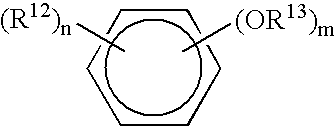Antimicrobial compositions and methods
a technology of compositions and antimicrobials, applied in the field of antimicrobial agents, can solve the problems of high resistance rate to this antibiotic, unrelenting, and even enhancing, and achieve the effect of reducing or eliminating bacterial colonization
- Summary
- Abstract
- Description
- Claims
- Application Information
AI Technical Summary
Benefits of technology
Problems solved by technology
Method used
Image
Examples
examples
[0316] Objects and advantages of this invention are further illustrated by the following examples, but the particular materials and amounts thereof recited in these examples, as well as other conditions and details, should not be construed to unduly limit this invention.
GLOSSARY of COMPONENTSAcronymTrade NameDescriptionSource / AddressGMLLAURICIDINGlycerol monolaurateMedChem Laboratories,Inc. / Galena, ILPURACLactic Acid (88%)Purac America / HIPURE 88Lincolnshire, ILMandelic AcidSigma-Aldrich / St. Louis, MOBenzoic acidMallinckrodt BakerInc. / Paris, KYSalicylic acidMallinckrodtBaker Inc.C10H23 glycerin ether(Preparationdescribed inExample 18)Propylene glycolUniquema / monocaprateWilmington, DECRODAPHOSPPG-5 ceteth-10Croda Inc. / SGphosphateParsipanny, NJDOSS,COMPLEMIXDioctylsulfosuccinate,Cytec Industries / 100%sodium salt (Docusate,West Paterson, NJsodium)DOSS,AEROSOL GPGDioctylsulfosuccinate,Cytec Industries70%sodium salt, 70% inethanol / waterPOLYSTEPSodium laureth-4Stepan Company / B12sulfateNor...
examples 3-7
[0320] Antimicrobial compositions were prepared as described in Examples 1-2 using the components shown in Table 2a. Mandelic acid was ground into a fine powder using a mortar and pestle and added to the glycerin and DOSS and heated to about 88° C. for Examples 3 and 4 or added directly to the hot, molten petrolatum at about 82° C. for Examples 5 and 6.
TABLE 2aComponents (weight percent)ExampleMandelicDOSSWhiteNo.GMLAcid(100%)GlycerinPetrolatum33.001.001.0010.0085.0043.030.920.0010.1185.9453.001.001.000.0095.0063.001.000.000.0096.0072.970.900.000.9695.17
[0321] The compositions of Examples 3-7 were evaluated using the Antimicrobial Kill Rate Test and the results are shown in Table 2b and 2c.
TABLE 2bMRSA (log reduction)E. coli (log reduction)ExampleAfter 2After 5After 10After 2After 5After 10No.minutesminutesminutesminutesminutesminutes33.65.75.94.05.66.142.83.94.35.75.66.055.05.85.45.45.86.362.42.63.63.23.33.772.33.14.14.03.94.7
[0322]
TABLE 2cExamplePseudomonas ae. (log reduction)...
example 8
[0324] An antimicrobial composition was prepared using the components listed in Table 3a. GML, isopropyl isosterate, beeswax and FINSOLV TN were combined in a beaker, heated and stirred with a propeller mixer until a clear solution was obtained. Stirring was continued while cooling the solution to about 48° C. when the lactic acid was added. Stirring and cooling continued until the temperature was 43° C. when the composition was removed from the mixer and poured into the ointment jar.
TABLE 3aComponents (weight percent)LacticExampleacidWhiteIsopropylFINSOLVNo.GML(88%)BeeswaxisosterateTN810.001.0020.0029.0040.00
[0325] The composition of Example 8 was evaluated using the Antimicrobial Kill Rate Test and the results are shown in Table 3b and 3c.
TABLE 3bMRSA (log reduction)E. coli (log reduction)ExampleAfter 2After 5After 10After 2After 5After 10No.minutesminutesminutesminutesminutesminutes8>6.3>6.3>6.37.37.37.3
[0326]
TABLE 3cExamplePseudomonas ae. (log reduction)No.After 2 minutesAft...
PUM
| Property | Measurement | Unit |
|---|---|---|
| temperature | aaaaa | aaaaa |
| path length | aaaaa | aaaaa |
| pH | aaaaa | aaaaa |
Abstract
Description
Claims
Application Information
 Login to View More
Login to View More - R&D
- Intellectual Property
- Life Sciences
- Materials
- Tech Scout
- Unparalleled Data Quality
- Higher Quality Content
- 60% Fewer Hallucinations
Browse by: Latest US Patents, China's latest patents, Technical Efficacy Thesaurus, Application Domain, Technology Topic, Popular Technical Reports.
© 2025 PatSnap. All rights reserved.Legal|Privacy policy|Modern Slavery Act Transparency Statement|Sitemap|About US| Contact US: help@patsnap.com


